
NGC 7320 is a spiral galaxy in the constellation Pegasus. It was discovered on 27 September 1873 by French astronomer Édouard Stephan.

NGC 5112 is a barred spiral galaxy in the constellation Canes Venatici. It was discovered on 17 March 1787 by German-British astronomer William Herschel. This galaxy is in close physical proximity to the edge-on dwarf spiral NGC 5107.

The Collinder catalogue is a catalogue of 471 open clusters compiled by Swedish astronomer Per Collinder. It was published in 1931 as an appendix to Collinder's paper On structural properties of open galactic clusters and their spatial distribution.

NGC 121 is a globular cluster of stars in the southern constellation of Tucana. It is the oldest globular cluster in the Small Magellanic Cloud (SMC), which is a dwarf satellite galaxy of the Milky Way. This cluster was first discovered by English astronomer John Herschel on September 20, 1835. The compiler of the New General Catalogue, Danish astronomer John Louis Emil Dreyer, described this object as "pretty bright, pretty small, little extended, very gradually brighter middle". The cluster is located at a distance of around 200,000 light-years (60 kpc) from the Sun.
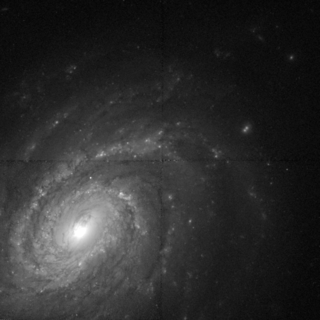
NGC 214 is a spiral galaxy in the northern constellation of Andromeda, located at a distance of 194 megalight-years from the Milky Way. It was discovered on September 10, 1784 by William Herschel. The shape of this galaxy is given by its morphological classification of SABbc, which indicates a weak bar-like structure (SAB) at the core and moderate to loosely-wound spiral arms (bc).
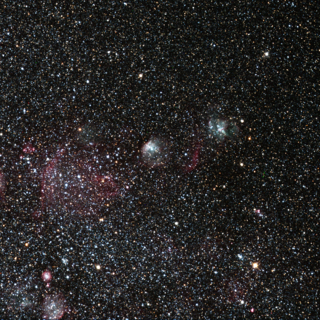
NGC 261 is a diffuse nebula located in the constellation Tucana. It was discovered on September 5, 1826, by James Dunlop.

NGC 266 is a massive barred spiral galaxy in the constellation Pisces. NGC 266 is located at a distance of 197 megalight-years from the Milky Way. It was discovered on September 12, 1784, by William Herschel. The form of this barred galaxy is described by its morphological classification of SB(rs)ab, which indicates a quasi-ring-like structure (rs) and moderate-to-tightly wound spiral arms (ab).

NGC 276 is a barred spiral galaxy located approximately 626 million light-years from the Solar System in the constellation Cetus. It was discovered in 1886 by Frank Muller and was later also observed by DeLisle Stewart.

NGC 315 is an elliptical galaxy in the constellation Pisces. Its velocity with respect to the cosmic microwave background is 4635 ± 22 km/s, which corresponds to a Hubble distance of 223.0 ± 15.7 Mly (68.36 ± 4.80 Mpc). In addition, eight non-redshift measurements give a distance of 208.58 ± 22.28 Mly (63.950 ± 6.830 Mpc). It was discovered by German-British astronomer William Herschel on September 11, 1784.
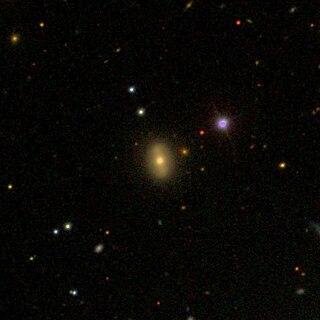
NGC 318 is a lenticular galaxy in the constellation Pisces. It was discovered on November 29, 1850 by Bindon Stoney.
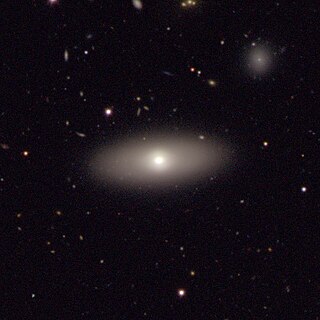
NGC 324 is a lenticular galaxy located in the constellation Phoenix. It was discovered on October 23, 1835, by John Herschel. It was described by Dreyer as "questionable, faint, small, stellar".

NGC 333 is a lenticular galaxy located approximately 755 million light years away in the constellation Cetus. It was discovered in 1877 by Wilhelm Tempel. It is recorded as NGC 333 in the New General Catalogue. It has a companion galaxy, named PGC 3073571, which is presumed to be a physical pair with NGC 333.

NGC 336 is a spiral galaxy in the constellation Cetus. It was discovered on October 31, 1885 by Francis Leavenworth. It was described by Dreyer as "very faint, small, round, suddenly brighter middle." It is also known as PGC 3470. Despite this, sometimes it is mistakenly identified as PGC 3526.

NGC 344 is a barred spiral galaxy in the constellation Cetus. It was discovered in 1886 by Frank Muller. It was described by John Louis Emil Dreyer as "extremely faint, very small, irregularly round, suddenly brighter middle and nucleus ."

NGC 359 is an elliptical galaxy located approximately 238 million light-years from the Solar System in the constellation Cetus. It was discovered on September 2, 1864, by Albert Marth. It was described by Dreyer as "extremely faint, very small."

NGC 361 is an open cluster in the Small Magellanic Cloud. It is located in the constellation Tucana. It was discovered on September 6, 1826, by James Dunlop. It was described by Dreyer as "very very faint, pretty large, very little extended, very gradually brighter middle." At an aperture of 31.0 arcseconds, its apparent V-band magnitude is 12.24, but at this wavelength, it has 0.40 magnitudes of interstellar extinction.

NGC 376 is a young open cluster of stars in the southern constellation of Tucana. It was discovered on September 2, 1826, by Scottish astronomer James Dunlop. Dreyer, a Danish/British astronomer, described it as a "globular cluster, bright, small, round." It is irregular in form, with a central spike.

NGC 410 is an elliptical galaxy located in the constellation Pisces. It was discovered on September 12, 1784 by William Herschel. It was described by Dreyer as "pretty bright, pretty large, northeastern of 2.", the other being NGC 407.
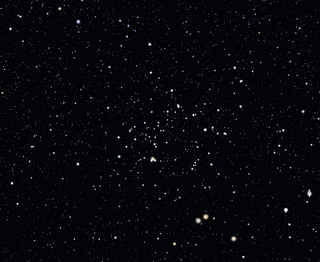
DS Andromedae is an eclipsing binary star in the constellation Andromeda and a member of the open cluster NGC 752. Its maximum apparent visual magnitude is 10.44, but drops down to 10.93 during the main eclipse and to 10.71 during the secondary one.

NGC 1325 is a flocculent spiral galaxy situated in the constellation of Eridanus. Located about 75 million light years away, it is a member of the Eridanus cluster of galaxies, a cluster of about 200 galaxies. It was discovered by William Herschel on 19 December 1799.




















